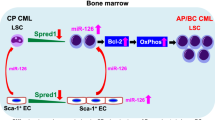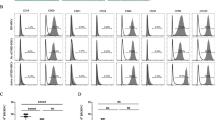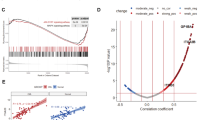Abstract
An increasing number of studies indicate that during development, endothelial and hematopoietic cells derive from common progenitors named hemangioblasts that have important roles in the pathogenesis. This is particularly true in chronic myeloid leukemia (CML). Here, we isolated fetal liver kinase-1-positive (Flk1+) cells from CML patients and found they expressed BCR/ABL-specific CML oncogene. We examined their biological characteristics as well as immunological functions and further detected the possible molecular mechanism involved in the leukemia genesis. We showed that CML patient-derived Flk1+CD31−CD34− mesenchymal stem cells (MSCs) had normal morphology, phenotype and karyotype but appeared impaired immuno-modulatory function. The capacity of Flk1+CD31−CD34− MSCs from CML patients to inhibit T lymphocyte activation and proliferation was impaired in vitro. CML patient-derived MSCs have dampening immuno-modulatory functions, suggesting that the dysregulation of hematopoiesis and immune response might originate from MSCs rather than hematopoietic stem cells (HSCs). These Ph+ putative CML hemangioblast upregulated TGF-β1 and resultantly activated matrix metalloproteinase-9 (MMP-9) to enhance s-KitL and s-ICAM-1 secretion, which activated c-kit+ HSCs from the quiescent state to the proliferative state. Further studies showed that phosphatidylinositol-3 kinase (PI3K)/Akt/nuclear factor (NF)-κB signaling pathway was involved in CML pathogenesis. Flk1+CD31−CD34− MSCs that express BCR/ABL leukemia oncogene are hemangioblasts and they have a critical role in the progression of CML through PI3K/Akt/NF-κB signaling pathway.
This is a preview of subscription content, access via your institution
Access options
Subscribe to this journal
Receive 12 print issues and online access
$259.00 per year
only $21.58 per issue
Buy this article
- Purchase on Springer Link
- Instant access to full article PDF
Prices may be subject to local taxes which are calculated during checkout









Similar content being viewed by others
References
Barnes DJ, Melo JV . Primitive, quiescent and difficult to kill: the role of non-proliferating stem cells in chronic myeloid leukemia. Cell Cycle 2006; 5: 2862–2866.
Jørgensen HG, Allan EK, Jordanides NE, Mountford JC, Holyoake TL . Nilotinib exerts equipotent antiproliferative effects to imatinib and does not induce apoptosis in CD34+CML cells. Blood 2007; 109: 4016–4019.
Jørgensen HG, Copland M, Allan EK, Jiang X, Eaves A, Eaves C et al. Intermittent exposure of primitive quiescent chronic myeloid leukemia cells to granulocyte-colony stimulating factor in vitro promotes their elimination by imatinib mesylate. Clin Cancer Res 2006; 12: 626–633.
Ries C, Pitsch T, Mentele R, Zahler S, Egea V, Nagase H et al. Identification of a novel 82 kDa proMMP-9 species associated with the surface of leukaemic cells: (auto-)catalytic activation and resistance to inhibition by TIMP-1. Biochem J 2007; 405: 547–558.
Yu Q, Stamenkovic I . Cell surface-localized matrix metalloproteinase-9 proteolytically activates TGF-β and promotes tumor invasion and angiogenesis. Genes Dev 2000; 14: 163–176.
Fridman R, Toth M, Chvyrkova I, Meroueh S, Mobashery S . Cell surface association of matrix metalloproteinase-9 (gelatinase B). Cancer Metastasis Rev 2003; 22: 153–166.
Stefanidakis M, Koivunen E . Cell-surface association between matrix metalloproteinases and integrins: role of the complexes in leukocyte migration and cancer progression. Blood 2006; 108: 1441–1450.
Paupert J, Mansat-De Mas V, Demur C . Cell-surface MMP-9 regulates the invasive capacity of leukemia blast cells with monocytic features. Cell Cycle 2008; 7: 1047–1053.
Redondo-Muñoz J, José Terol M, García-Marco JA . Matrix metalloproteinase-9 is up-regulated by CCL21/CCR7 interaction via extracellular signal-regulated kinase-1/2 signaling and is involved in CCL21-driven B-cell chronic lymphocytic leukemia cell invasion and migration. Blood 2008; 111: 383–386.
Redondo-Muñoz J, Escobar-Díaz E, Samaniego R . MMP-9 in B-cell chronic lymphocytic leukemia is up-regulated by alpha4beta1 integrin or CXCR4 engagement via distinct signaling pathways, localizes to podosomes, and is involved in cell invasion and migration. Blood 2006; 108: 3143–3151.
Shishodia S, Sethi G, Konopleva M, Andreeff M, Aggarwal BB . A synthetic triterpenoid, CDDO-Me, inhibits IkappaBalpha kinase and enhances apoptosis induced by TNF and chemotherapeutic agents through down-regulation of expression of nuclear factor kappaB-regulated gene products in human leukemic cells. Clin Cancer Res 2006; 12: 1828–1838.
Janowska-Wieczorek A, Majka M, Marquez-Curtis L, Wertheim JA, Turner AR, Ratajczak MZ et al. Bcr-abl-positive cells secrete angiogenic factors including matrix metalloproteinases and stimulate angiogenesis in vivo in Matrigel implants. Leukemia 2002; 16: 1160–1166.
Kaneta Y, Kagami Y, Tsunoda T, Ohno R, Nakamura Y, Katagiri T et al. Genome-wide analysis of gene-expression profiles in chronic myeloid leukemia cells using a cDNA microarray. Int J Oncol 2003; 23: 681–691.
Bruchova H, Borovanova T, Klamova H, Brdicka R . Gene expression profiling in chronic myeloid leukemia patients treated with hydroxyurea. Leuk Lymphoma 2002; 43: 1289–1295.
Ries C, Loher F, Zang C, Ismair MG, Petrides PE . Matrix metalloproteinase production by bone marrow mononuclear cells from normal individuals and patients with acute and chronic myeloid leukemia or myelodysplastic syndromes. Clin Cancer Res 1999; 5: 1115–1124.
Kim JG, Sohn SK, Kim DH, Baek JH, Lee NY, Suh JS et al. Clinical implications of angiogenic factors in patients with acute or chronic leukemia: hepatocyte growth factor levels have prognostic impact, especially in patients with acute myeloid leukemia. Leuk Lymphoma 2005; 46: 885–891.
Yoon S-O, Shin S, Lee H-J . Isoginkgetin inhibits tumor cell invasion by regulating phosphatidylinosito 3 kinase/Akt dependent matrix metalloproteinase-9 expression. Mol Cancer Ther 2006; 5: 344–349.
Anand P, Sundaram C, Jhurani S, Kunnumakkara AB, Aggarwal BB . Curcumin and cancer: an "old-age" disease with an "age-old" solution. Cancer Lett 2008; 267: 133–164.
Baijun F, Chunmei Z, Liao L, Shi M, Yang S, RCH Z et al. Identification of human chronic myelogenous leukemia progenitor cells with hemangioblastic characteristics. Blood 2005; 105: 2733–2740.
Reyes M, Lund T, Lenvik T, Aguiar D, Koodie L, Verfaillie CM et al. Purification and ex vivo expansion of postnatal human marrow mesodermal progenitor cells. Blood 2001; 98: 2615–2625.
Guo H, Fang B, Zhao RC . Hemangioblastic characteristics of fetal bone marrow-derived Flk1(+)CD31(-)CD34(-) cells. Exp Hematol 2003; 31: 650–613.
Lu Y, Wahl LM . Production of matrix metalloproteinase-9 by activated human monocytes involves a phosphatidylinositol-3 kinase/Akt/IKK/NF-κB pathway. J Leuk Biol 2005; 78: 259–265.
Gustin JA, Ozes ON, Akca H, Pincheira R, Mayo LD, Li Q et al. Cell type-specific expression of the IκB kinases determines the significance of phosphati-dylinositol 3-kinase/Akt signaling to NF-κ B activation. J Biol Chem 2004; 279: 1615–1620.
Radisky DC, Levy DD, Littlepage LE, Liu H, Nelson CM, Fata JE et al. Rac1b and reactive oxygen species mediate MMP-3-induced EMT and genomic instability. Nature 2005; 436: 123–127.
Karanes C, Nelson GO, Chitphakdithai P, Agura E, Ballen KK, Bolan CD et al. Twenty years of unrelated donor hematopoietic cell transplantation for adult recipients facilitated by the National Marrow Donor Program. Biol Blood Marrow Transplant 2008; 14: 8–15.9.
Martin MG, Dipersio JF, Uy GL . Management of the advanced phases of chronic myelogenous leukemia in the era of tyrosine kinase inhibitors. Leuk Lymphoma 2008; 29: 1–10.
Martinelli G, Soverini S, Iacobucci I, Baccarani M . Intermittent targeting as a tool to minimize toxicity of tyrosine kinase inhibitor therapy. Nat Clin Pract Oncol 2008; 6: 68–69.
Catriona H, Jamieson Y . Chronic myeloid leukemia stem cell. Hematology Am Soc Hematol Educ Program 2008; 34: 436–442.
Pelletier SD, Hong DS, Hu Y, Liu Y, Li S . Lack of the adhesion molecules P-selectin and intercellular adhesion molecule-1 accelerate the development of BCR/ABL-induced chronic myeloid leukemia-like myeloproliferative disease in mice. Blood 2004; 104: 2163–2171.
Martin-Henao GA, Quiroga R, Sureda A, González JR, Moreno V, García J et al. L-selectin expression is low on CD34+ cells from patients with chronic myeloid leukemia and interferon-a up-regulates this expression. Haematologica 2000; 85: 139–146.
Wertheim JA, Forsythe K, Druker BJ, Hammer D, Boettiger D, Pear WS et al. BCR-ABL-induced adhesion defects are tyrosine kinase-independent. Blood 2002; 99: 4122–4130.
Fiore E, Fusco C, Romero P . Matrix metalloproteinase 9 (MMP-/gelatinase B) proteolytically cleaves ICAM-1 and participates in tumor cell resistance to natural killer cell-mediated cytotoxicity. Oncogene 2002; 21: 5213–5223.
Darai E, Stefanidakis M, Koivunen E . Cell-surface association between matrix metalloproteinases and integrins: role of the complexes in leukocyte migration and cancer progression. Blood 2006; 108: 1441–1450.
Molica S, Vitelli G, Levato D, Giannarelli D, Vacca A, Cuneo A et al. Increased serum levels of matrix metalloproteinase-9 predict clinical utcome of patients with early B-cell chronic lymphocytic leukemia. Eur J Haematol 2003; 10: 373–378.
Kamiguti AS, Lee ES, Till KJ, Harris RJ, Glenn MA, Lin K et al. The role of matrix metalloproteinase 9 in the pathogenesis of chronic lymphocytic leukaemia. Br J Haematol 2004; 125: 128–140.
Yue J, Mulder KM . Transforming growth factor-h signal transduction in epithelial cells. Pharmacol Ther 2001; 91: 1–34.
Mucsi I, Skorecki KL, Goldberg HJ . Extracellular signal-regulated kinase and the small GTP-binding protein, Rac, contribute to the effects of transforming growth factor-h1 on gene expression. J Biol Chem 1996; 271: 16567–16572.
Munshi HG, Wu YI, Mukhopadyay S . Differential regulation of membrane type 1-matrix metalloproteinase activity by ERK 1/2 and p38 MAPK-modulated tissue inhibitor of metalloproteinase expression controls transforming growth factor-h1-induced pericellular collagenolysis. J Biol Chem 2004; 279: 39042–39050.
Kim ES, Kim MS, Moon A . TGF-h-induced upregu-lation of MMP-2 and MMP-9 depends on p38 MAPK, but not ERK signaling in MCF10A human breast epithelial cells. Int J Oncol 2004; 25: 1375–1382.
Horowitz JC, Lee DY, Waghray M . Activation of the pro-survival phosphatidylinositol 3-kinase/AKTpathway by transforming growth factor-h1 in mesenchymal cells is mediated by p38 MAPK-dependent induction of an autocrine growth factor. J Biol Chem 2004; 279: 1359–1367.
Bakin AV, Tomlinson AK, Bhowmick NA, Moses HL, Arteaga CL . Phosphatidylinositol 3-kinase function is required for transforming growth factor b-medicated epithelial to mesenchymal transition and cell migration. J Biol Chem 2000; 275: 36803–36810.
Kim WK, Hwang SY, Oh ES, Piao HZ, Kim KW, Han IO et al. TGF-beta1 represses activation and resultant death of microglia via inhibition of phosphatidylinositol 3-kinase activity. J Immunol 2004; 172: 7015–7023.
Rahimi RA, Andrianifahanana M, Wilkes MC . Distinct roles for mammalian target of rapamycin complexes in the fibroblast response to transforming growth factor-beta. Cancer Res 2009; 69: 84–93.
Assinder SJ, Dong Q, Mangs H, Richardson DR . Pharmacological targeting of the integrated protein kinase B, phosphatase and tensin homolog deleted on chromosome 10, and transforming growth factor-beta pathways in prostate cancer. Mol Pharmacol 2009; 75: 429–436.
Rexer BN, Engelman JA, Arteaga CL . Overcoming resistance to tyrosine kinase inhibitors: Lessons learned from cancer cells treated with EGFR antagonists. Cell Cycle 2009; 8: 18–22.
Papakonstanti EA, Zwaenepoel O, Bilancio A, Burns E, Nock GE, Houseman B et al. Distinct roles of class IA PI3K isoforms in primary and immortalised macrophages. J Cell Sci 2008; 121: 4124–4133.
Williams M.R, Arthur J.S, Balendran A, van der Kaay J, Poli V, Cohen P et al. The role of 3-phosphoinositide-dependent protein kinase 1 in activating AGC kinases defined in embryonic stem cells. Curr Biol 2000; 10: 439–448.
Gustin JA, Ozes ON, Akca H, Pincheira R, Mayo LD, Li Q et al. Cell type-specific expression of the IκB kinases determines the significance of phosphati-dylinositol 3-kinase/Akt signaling to NF-κB activation. J Biol Chem 2004; 279: 1615–1620.
Ben-Neriah Y . Regulatory functions of ubiquitination in the im-mune system. Nat Immunol 2002; 3: 20–26.
Author information
Authors and Affiliations
Corresponding authors
Ethics declarations
Competing interests
The authors declare no conflict of interest.
Rights and permissions
About this article
Cite this article
Li, Q., Wu, Y., Fang, S. et al. BCR/ABL oncogene-induced PI3K signaling pathway leads to chronic myeloid leukemia pathogenesis by impairing immuno-modulatory function of hemangioblasts. Cancer Gene Ther 22, 227–237 (2015). https://doi.org/10.1038/cgt.2014.65
Received:
Revised:
Accepted:
Published:
Issue Date:
DOI: https://doi.org/10.1038/cgt.2014.65
This article is cited by
-
C-Myc inhibition intensified the anti-leukemic properties of Imatinib in chronic myeloid leukemia cells
Molecular Biology Reports (2023)
-
The Superior Cytotoxicity of Dual Targeting of BCR/ABL and PI3K in K562 Cells: Proposing a Novel Therapeutic Potential for the Treatment of CML
Indian Journal of Hematology and Blood Transfusion (2022)
-
FAM168A participates in the development of chronic myeloid leukemia via BCR-ABL1/AKT1/NFκB pathway
BMC Cancer (2019)
-
The Philadelphia chromosome in leukemogenesis
Chinese Journal of Cancer (2016)



